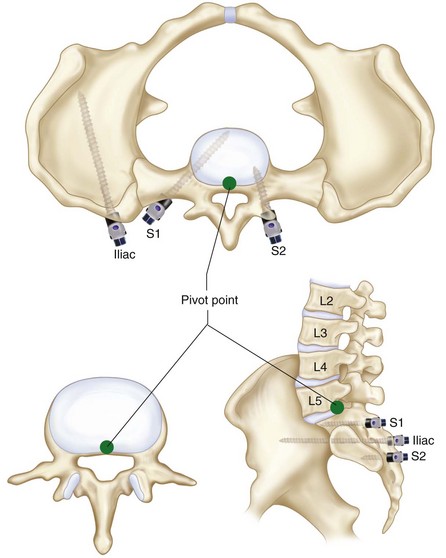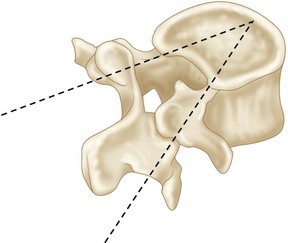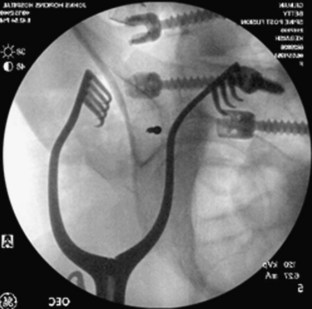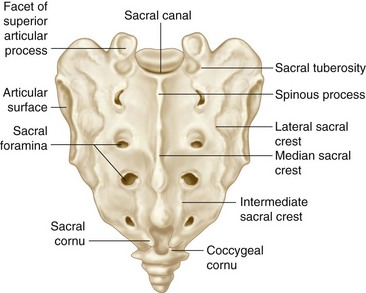Procedure 25 Sacropelvic Fixation
Indications
 Long spinal fusion to the sacrum
Long spinal fusion to the sacrum
 Degenerative spinal deformities
Degenerative spinal deformities
 Spondylolisthesis (high grade)
Spondylolisthesis (high grade)
Indications Pitfalls
• Variable anatomy of the sacrum and pelvis may add challenge to the procedure.
• The sacrum has poor bone quality, mainly cancellous and often osteoporotic.
• The sacropelvis functions as a unit; this segment must transmit the full weight of the body from the spine to one or both femoral heads. It must do this in a static environment, such as sitting or standing, and in a dynamic environment, such as walking and running.
• Large loads going through this segment, creating cantilever pullout forces, are the primary reasons for construct failure.
Indications Controversies
• Long fusion has been described by some authors as four levels extending to L2, while others define a long fusion as one that crosses the thoracolumbar junction.
• The long lever arm generated by incorporating more segments into the fusion requires additional fixation points to achieve a rigid construct at the lumbosacral junction.
• High risk of pseudarthrosis (9% to 41%), instrumentation failure (3% to 44%), and loss of lumbar lordosis (20% to 49%) are associated with fusion down to the sacrum.
• Terminating a long fusion at L5 might lead to subsequent degeneration of the L5-S1 disk and might impact sagittal balance.
• Degeneration of the sacroiliac (SI) joint, although so far not clinically significant, might be a concern in patients with implants violating the sacroiliac articulation (iliac and S2AI screws).
Biochemical Considerations
 The lumbosacral junction is a transition from a highly mobile segment to a stiff segment, resulting in great stress concentrations when the biomechanics of this segment are altered by instrumentation and fusion. Forces include axial loading of up to 3 times body weight in activities of daily living; substantial shear, especially with a more vertical S1 end-plate alignment; flexion/extension moments; and torsion.
The lumbosacral junction is a transition from a highly mobile segment to a stiff segment, resulting in great stress concentrations when the biomechanics of this segment are altered by instrumentation and fusion. Forces include axial loading of up to 3 times body weight in activities of daily living; substantial shear, especially with a more vertical S1 end-plate alignment; flexion/extension moments; and torsion.
 The following three concepts are crucial in understanding the biomechanics of lumbosacral fixation and its relevance to the stiffness of the cephalad construct.
The following three concepts are crucial in understanding the biomechanics of lumbosacral fixation and its relevance to the stiffness of the cephalad construct.
 Lumbosacral pivot point (McCord et al, 1992)
Lumbosacral pivot point (McCord et al, 1992)
Examination/Imaging
 Pelvic obliquity and sacral inclination should be noted, especially in cerebral palsy patients.
Pelvic obliquity and sacral inclination should be noted, especially in cerebral palsy patients.
 Obtain spot lateral and true anteroposterior films of sacrum.
Obtain spot lateral and true anteroposterior films of sacrum.
 It is useful to visualize the sacral promontory, superior articular process (SAP), sacral foramina, and the first to third sacral segments.
It is useful to visualize the sacral promontory, superior articular process (SAP), sacral foramina, and the first to third sacral segments.
 For long spinal fusion to the pelvis, radiographic evaluation should include long-cassette, erect posteroanterior and lateral views to determine balance.
For long spinal fusion to the pelvis, radiographic evaluation should include long-cassette, erect posteroanterior and lateral views to determine balance.
 In patients with dural ectasia, variable anatomy or revision cases, attention should be paid to the proximity of the abnormality to the entry point of the screws to avoid injury of the neural elements.
In patients with dural ectasia, variable anatomy or revision cases, attention should be paid to the proximity of the abnormality to the entry point of the screws to avoid injury of the neural elements.
 Obtain a dual emission x-ray absorptiometry (DEXA) scan, especially in females greater than 50 years of age, because bone density correlates with screw pullout forces.
Obtain a dual emission x-ray absorptiometry (DEXA) scan, especially in females greater than 50 years of age, because bone density correlates with screw pullout forces.
 Intraoperative teardrop view of the pelvis allows safe placement of iliac and sacroiliac screws in the bony canal between the posterior superior iliac spine (PSIS) and anterior inferior iliac spine (AIIS). Figure 25-4 shows an intraoperative radiograph showing a teardrop view with the guidewire within an all-osseous channel between the PSIS and AIIS.
Intraoperative teardrop view of the pelvis allows safe placement of iliac and sacroiliac screws in the bony canal between the posterior superior iliac spine (PSIS) and anterior inferior iliac spine (AIIS). Figure 25-4 shows an intraoperative radiograph showing a teardrop view with the guidewire within an all-osseous channel between the PSIS and AIIS.
 An intraoperative teardrop view is obtained by a combined obturator oblique–outlet view, with an approximately compound 45-degree anterior and 45-degree cephalad angulation of the beam. Figure 25-5 is a schematic representation of the position of the pelvis while obtaining a teardrop view with superimposed shadows of the PSIS and AIIS and iliac rim above the sciatic notch.
An intraoperative teardrop view is obtained by a combined obturator oblique–outlet view, with an approximately compound 45-degree anterior and 45-degree cephalad angulation of the beam. Figure 25-5 is a schematic representation of the position of the pelvis while obtaining a teardrop view with superimposed shadows of the PSIS and AIIS and iliac rim above the sciatic notch.
Positioning
 Positioning is according to the procedure being done; the vast majority of patients are positioned prone. Lumbar lordosis is maintained by pads placed to support the chest, iliac crests, and thighs. The abdomen is left hanging free, decreasing intraabdominal pressure. This decreases epidural bleeding.
Positioning is according to the procedure being done; the vast majority of patients are positioned prone. Lumbar lordosis is maintained by pads placed to support the chest, iliac crests, and thighs. The abdomen is left hanging free, decreasing intraabdominal pressure. This decreases epidural bleeding.





















